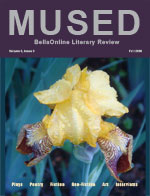Shahasp Valentine
Lisa Shea
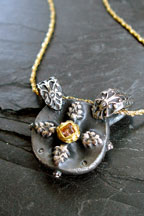
Sometimes the most beautiful works of art are hidden in plain view, jewels of beauty which we may often overlook if we're not practicing careful attentiveness. The glistening drop of dew on a scarlet rose petal. The fluffed up cerulean blue of a baby bird. The intricate detail, the amazing composition on a Lilliputian scale which goes into jewelry creation.
Shahasp Valentine has been designing, sculpting and creating fine jewelry for almost twenty years. Her talents have brought her through the realms of beading, soldering, casting, lost wax, precious metal clay, and many other artisan techniques. Some of her pieces seem to have been forged in the red-hot volcanic tunnels of the earth, while others mirror the intricately detailed stained glass masterpieces of France.
Shahasp delved into the world of jewelry creation at an early age. "I started taking jewelry classes with my mom at the local community center while I was in junior high. She's always been an artist and designer so I grew up sewing, painting, making all sorts of crafts. So, at the junior high age I was learning lost wax, investing, casting, and some soldering which was a great foundation. Later in high school I did a lot of fabrication as well. The single most useful class I've taken is Wax Carving. I'd been carving my original designs in Fimo with tools at hand." Fimo is a polymer clay that is molded and then baked in an oven to a hard finish. "Once I took the class and learned the right waxes to use and had the correct tools it became much easier, and the quality of my carvings improved."
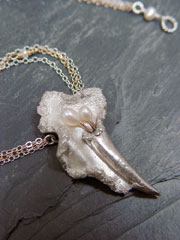
Shahasp's development of her jewelry style sprang from these early creative tendencies. "Since I was in junior high I'd had the Lily idea, but couldn't get the result in my vision with traditional methods. When I heard of Precious Metal Clay (PMC), my head went right there - I bought some and went for it."
PMC has been an enormous treat for jewelry designers. In essence PMC is precious metals - copper, silver, gold - provided in soft Play-Doh style clay. You mold, carve and shape the clay in any way you wish. Then you bake the clay in a kiln. The clay part vanishes, and you're left with a solid metal object in exactly the form you desired.
"The Organic Rings followed in the Organic Series. With other groups following like the Waves and Knife Edge. The medium gave me the opportunity to create the Precieux Series work in the way I've always wanted it to be. Production and casting has never interested me. I'm more of a one-of-a-kind fabricated and unique girl."
Fresh ideas for Shahasp's designs flow from exploring the many cultures of the world. "Travel is so inspirational. For example, I went on a trip to Africa. While on the Indian Ocean side, the tide pools were so amazing, I was so inspired that I came home and created the Habitat Series which represent tide pools with small anemones and little creatures living amongst the nooks and crannies of larger anemones. You never know what's going to inspire you. At a castle in the U.K., I was totally inspired by some huge chain between fences with sort of barbed wire links. I created a chain that was similar when I got home. Same with flowers, you never know what'll grab you. Sometimes it's just being out of your environment."
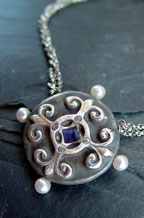
As Shahasp explains, "With PMC I could create an original, yet have each piece I make be unique. I've been making jewelry of various kinds for years along with sewing/fashion, art and crafts. The PMC line is actually my third jewelry business. The first was lots of beads and chain. The second was bridal jewelry which was production-oriented. I learned pretty quickly that it was a money maker but wasn't fun. When I heard of PMC in 1998 or 1999 I dropped the bridal jewelry business and went headlong into PMC."
Shahasp is an enthusiastic fan of PMC. You don't need to "study" PMC to work with it. "The funny thing is that the only PMC class I've ever taken is the certification. I'm completely self taught with PMC. But having said that, I've taken many jewelry classes that apply and a ceramics background which makes a big difference."
"I developed my own process to create my original designs. You'll notice in the Precieux Series the patterns are four equal parts. I draw one quarter of the pattern by hand, then scan it into the computer, refine and perfect it, then rotate the image to create a design of the four pieces put together. Then I print out the design in various sizes, trace onto wax and carve. Next I make a mold, press the PMC into the mold, massage the PMC out, set the stones and findings, then dry and fire it with stones and findings in place."
PMC also helps create very small designs. Shahasp's intricate medallion necklaces are often under two inches in diameter. "The only trick with detail is a good mold off your original and really wet PMC to get crisp detail. And if you mold a finished piece you can shrink the detail down and down. Several of my designs were carved larger and shrunk this way."
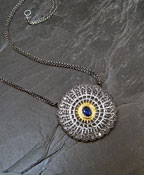
Many people design jewelry for their own use and pleasure. It is often a struggle to cross over into selling jewelry as a living. Shahasp explains, "The biggest challenge is figuring out first, whether you want to sell direct (store by store), or whether to do shows. If it's the latter, whether to do wholesale or retail shows, and which shows are the best places to sell your work. The challenges are: with selling store by store, it's hard to get your foot in the door without an introduction, and it's very time consuming and generally only local. With shows it's choosing the right ones first and foremost and coming up with the cash and a booth whether retail or wholesale."
"Another point about this is creating your image, and if you're going to have a booth for shows what image you want to convey. This is deep, all the way down to your business name, logo type and logo, marketing materials, web site, and general style. It's important to reflect your own style but you have to know what that is first."
Jewelry artists have a variety of options in selling their wares. "Wholesale and retail are two completely different animals. In retail craft shows people either like your work and booth, or they don't. If they've heard of you it makes a big difference. Wholesale shows are different. Buyers either need to absolutely
love your work to take a chance if it is the first time they see you or they must somehow have heard of you or already know of you. This is where press comes in for either retail or wholesale. Sometimes store buyers need to see you several times before they're willing to commit to make sure you're not flaky."
"Doing shows is a hard lifestyle. Retail shows are great because you're connecting with the end user and you get direct feedback. Wholesale shows are very tiring and expensive but there's a lot of fun to be had after hours as all your jewelry and art/craft friends are there and there are lots of parties and new people to meet. Lots of networking opportunities, too."
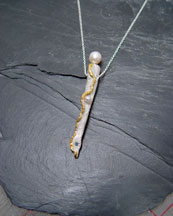
It is critical to be diligent in approaching your retail sales choices. "The first thing is to target the right stores. You have to do your homework. You can either walk in and ask for the owner or buyer and see what happens; sometimes this works, and sometimes it doesn't. If it's the right store for you, you can get the name of the person to contact, call for an appointment or mail them a catalog or line sheet. Cold calling can work but it's hard. And you need to know the store is right for your work. Direct mailing can work if you call first and then follow up. Personally I've tried all these things including wholesale shows. There's no one thing that works like magic, it's cumulative."
The economy is struggling, which can be challenging for artists in all genres. In the PMC world, while the artist pays substantial money for the silver-infused PMC clay, the buyer might see it as
only silver and not be willing to pay a commensurate price for the finished piece. "This is why I add a little gold to a lot of my pieces to add value. But for newcomers to PMC I'd say practice with bronze until you get good before spending lots on silver. My pieces are very very heavy so I've got a lot of silver in a piece. With the prices right now, it is cost prohibitive."
Another challenge for modern artists is the web. While it helps an artist get found, it also means that hundreds of other cheaper knock-off sites will offer similar items for one-tenth the cost. How does a truly talented woman hold her own? "If you promote and think of yourself as an artist it puts you in a different realm from production jewelers. You need to choose which you're going to be. Again this is where getting some press comes in. I always display my portfolio and blow-ups of magazine covers or feature articles to add credibility for those who don't know me. Also if you want to be an artist, focus on the art/handmade shows not hobbyist craft shows or street fairs."
With the amazing level of detail in Shahasp's creations, you would expect to find them in museums. For some reason, society puts high value on giant artworks - sculptures, ceiling mosaics - but less emphasis on smaller works of art and jewelry. Shahasp feels earning this appreciation from society is an ongoing effort. "Museum shows for jewelry are fairly rare but they do happen. A lot of museums have a jewelry section. More and more are aware of the contemporary craft and art jewelry movement. This also raises awareness in the general public. However, it's a long road before art jewelers are more highly recognized."
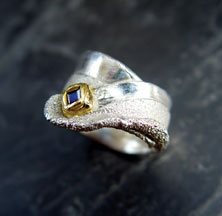
Some museums and buyers draw a distinction between art jewelry and high fine jewelry. "Art jewelry, also called contemporary craft jewelry, is usually more silver than gold or platinum. The gems are often semi precious rather than precious, or at times there are no gems at all. The value in art jewelry is more based on the artist and the techniques that are used, usually each piece being one of a kind. In comparison, fine jewelry is often cast in multiples and sent through an assembly line to set stones and finish the pieces. Thatís not to say there isn't art is the fine jewelry genre as well, there is but that's usually very high end and elite."
"There's a rift between art and high fine jewelry, the difference being that a lot of the high fine jewelry is manufactured. The fans of high fine value the work because of its intrinsic value. Art jewelry is usually only silver which the high fine folks don't value. It's two different worlds."
Shahasp leaves us with this inspiring message: "I think that anyone can do what I've done. Create what you love, love what you do. It's hard work to be sure but there's nothing more satisfying than creating something from nothing and watching it grow and blossom."
Visit Shahasp's Website:
http://www.precieux.com/
